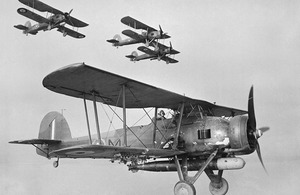Navy commemorates 70th anniversary of Battle of Taranto
Today marks the 70th anniversary of the Battle of Taranto, when, on 11 November 1940, for the first time in history, an enemy fleet was largely destroyed by naval aircraft launched from a ship at sea.

Royal Navy Swordfish biplanes largely destroyed the Italian fleet at anchor in the port of Taranto on the night of 11 November 1940 [Picture: Imperial War Museum]
Operation JUDGEMENT, as the mission to attack the Italian fleet at Taranto was called, involved the aircraft carrier HMS Illustrious and Swordfish biplane torpedo attack aircraft flown by Royal Navy pilots from the Fleet Air Arm.
Commander-in-Chief Mediterranean, Admiral Cunningham, said at the time:
Taranto, and the night of November 11-12 1940, should be remembered for ever as having shown once and for all that in the Fleet Air Arm the Navy has its most devastating weapon.
In the days before the attack, reconnaissance flights from Malta confirmed that the Italian fleet was at Taranto. This information was further confirmed on the night of 11 November 1940 with an overflight by a RAF Short Sunderland flying boat.
Aboard HMS Illustrious, 21 Royal Navy Swordfish biplanes began taking off. 11 of the planes were armed with torpedoes, while the remainder carried flares and bombs.
Approaching the harbour from the south west at 2258hrs, the first wave of 12 Swordfish biplanes found six battleships, seven heavy cruisers, two light cruisers and eight destroyers at anchor. As they began their attack, the sky was illuminated by flares and intense anti-aircraft fire.
Around midnight, the second wave of nine Swordfish biplanes arrived over the harbour from the north west. Dropping their ordnance, they cleared the harbour and returned to their carrier.
The Swordfish aircraft left the battleship Conte di Cavour sunk and the battleships Littorio and Caio Duilio heavily damaged. They also badly damaged a heavy cruiser. Two of the Swordfish were lost.
In one night, the Royal Navy succeeded in halving the Italian battleship fleet and gained the advantage in the Mediterranean.
Daring, innovation and determination remain critical characteristics of naval aviation and naval aviators continue to deliver highly adaptable military effect around the world. HMS Manchester, a Type 42 destroyer, is in the Caribbean providing assistance to British territories and commonwealth countries in Hurricane season and her Lynx helicopter, from the same squadron that led the attack at Taranto, 815 Naval Air Squadron (NAS), has been assisting in delivering aid to residents of St Lucia after Hurricane Tomas passed over the island.
Earlier this year, the 815 NAS Lynx helicopter from HMS Chatham saved the lives of 23 crew from the merchant vessel Dubai Moon when the vessel was caught in a tropical storm and about to run aground. 815 Naval Air Squadron provides helicopters that operate from the Royal Navy’s frigates and destroyers.
In Afghanistan, Sea Kings from 845 and 846 Naval Air Squadrons of the Commando Helicopter Force provide daily lift capability support to operations - they are now approaching three years of continuous service in Afghanistan.
Meanwhile Sea Kings from 854 and 857 Naval Air Squadrons, normally employed to provide airborne early warning, are currently providing vital situational awareness in support of operations on the ground in Afghanistan.
Today’s head of the Fleet Air Arm, Rear Admiral Tom Cunningham, Chief of Staff (Aviation and Carriers), said:
The success of the strike against the Italian battle fleet in Taranto typified the bravery and spirit of the Fleet Air Arm which continues to this day. Air operations from the sea remain as relevant today as they did back in 1940 and the Fleet Air Arm continues to be an integral capability both to Defence and the Royal Navy.
It operates across the full spectrum of operations, from war-fighting to disaster relief, and in all environments ranging from the mountains of Afghanistan to supporting counter-piracy operations in the Gulf of Aden.
The type of aircraft used at the battle of Taranto, the Swordfish, is still flying today. The Royal Navy Historic Flight was established at Royal Naval Air Station Yeovilton in 1972 in order to preserve naval heritage and to be a living memorial to all Fleet Air Arm personnel, especially those who gave their lives in maintaining the freedom of our nation.
The first aircraft to join this unique collection was the Swordfish II LS326, and she has been seen most recently at Duxford as part of its first air show in 11 years.
Second World War Swordfish pilot Bruce Vibert, who flew the aircraft on Russian convoy escort duty to defeat the U-boat submarine threat, said:
Given the job we had to do, thank God the Swordfish was there.